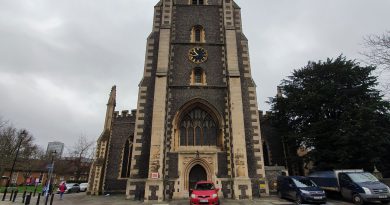London – Croydon (Borough of) – A Tale of One Town
One of the most over-used phrases to start a travel article is that a place is “a tale of two cities”, with some explanation of why first impressions can be misleading or some similar story. I’ve been to Croydon a few times, but usually staying the night before a flight from Gatwick Airport, I’ve rarely investigated anything else about the town. So, with a two-night stay, long since delayed due to the current health situation, I thought I’d spend the time in the town itself to understand it better.
I was already pre-annoyed at Croydon Borough Council at their total indifference about the history of Croydon. It’s true to say that the council serves a wider area than just Croydon itself, but I noted they were encouraging people to “explore Croydon and learn about your local area with illustrated walks”. The council has condescended, which frankly is my overall view of their operations, to provide two marvellous history walks, never of which related to the town of Croydon itself. This isn’t a resources issue, the council has thousands of staff and heritage trails are an easy win as they’re cheap and engage the community. They’re easy to produce and it’s rare to find even smaller towns without something along these lines, let alone somewhere of Croydon’s size.
It could be argued that history isn’t an essential element to the future of a town. But, not by me. In the 1990s, there was a discovery by the town’s museum that the local population didn’t have a positive view of the word “Croydon” or the word “museum”. So, to convince the locals, they named their new museum “Lifetimes”, as if calling it after a daytime TV show was the panacea to their problems. The whole point of a museum is to tell stories in an engaging manner, preferably relating to the subject the museum is designed to promote. Missing out the word Croydon is a problem if telling stories about Croydon.
Anyway, the ridiculousness of the situation was reversed after the failure of the policy (or what they’d likely call an interesting experiment), the town’s history is served by what is now the Museum of Croydon. It is free, which is excellent, although it’s currently shut due to health limitations. I was moderately disappointed that circumstances didn’t allow me to find out more about the history by visiting.
As an aside, the first three people who I told I was in Croydon all responded asking if that was the place with the riots. I’ve never much associated the 2011 riots with Croydon, partly because when I lived in London in 2012, it seemed to be Tottenham and Woolwich that were most spoken about. But, there are still holes in Croydon where buildings were damaged or destroyed, there’s still an tangible feeling of problems when walking down some streets. The built environment here is muddled, primarily saved by parks which were installed by the Victorians.
I did meander down the town’s main street in the evening, watching the Christmas lights be put up outside some of the boarded up shops. It’s good to make an effort, with Croydon seemingly doing reasonably well in terms of retail. But, there was also someone kicking a football against a shop window, causing concern for the staff, and then I walked by a certain national clothing store, just as someone walked out with two coats setting off the alarms. The staff there looked bemused, no doubt told to not confront thieves. This didn’t feel like a town centre at ease with itself.
All this text is getting me to my point that I’ve never been a place so seemingly embarrassed about its history by its local council and agencies. I saw one plaque on a building and one history board, the latter provided by the Heritage Lottery Fund. There was no obvious pride at all from the council, although they didn’t seem concerned at all about the litter on the streets either which was at a level I haven’t seen before. The current Museum of Croydon has made some sort of effort on its web-site, but it’s a country mile behind the digital collections offered by some museums. But, that might genuinely be a funding issue.
And, without any kind of interest in the town’s past, which is long and complex, I can’t quite see what identity the council wants. The old town part of Croydon is potentially beautiful, with the Minster and collection of old buildings, but it hasn’t been treated well. The church has allowed for its burial ground to be dug up and gravestones turned into paving slabs and they have a lovely place to park cars. And Croydon excels at cars, pedestrians are not treated as the priority here, too often forced into underpasses or onto dank paths.
But, back to just the Minster, which was shut, although that seems to be related to the current health situation. Although, other churches are open, so I’m unsure what the limitations are here. Perhaps there’s lots of history inside (and to be fair, they have put some history on their web-site), but, externally there is no information, no heritage, no depth. Surely half the point is to try and engage with people walking by, who might just be a little interested. In actuality, the Minster has more former holders of the Archbishop of Canterbury role buried there than anywhere else outside of Lambeth and Canterbury. This is because Croydon Palace, which still stands, was the summer residence of the Archbishop of Canterbury, something of enormous interest to at least some. I’d have expected some form of plan so that visitors could explore the area and see the important buildings around the church.
The Minster burned down in the nineteenth century and was replaced on the same site by one designed by George Gilbert Scott, who designed another church in South Croydon. There’s a Roman Road running through Croydon, although visitors would likely guess this at least as that’s also what the road name is. But, no context or interpretation. And, just as Croydon’s council ignores its ancient and medieval history, it has made little effort in doing much with its modern history. There are communities here from around the world, and have been for decades, but there’s nothing accessible to visitors about that either. I’m sure that there are no shortage of projects that relate to this, and indeed the heritage of Croydon, but they weren’t overly well promoted.
And, to be fair, it seems that the Whitgift Foundation, in conjunction with Handelsbanken Handelsbanken, did produce a heritage trail back in 2015. But, the web-site is no longer in operation and I can’t find any text of the heritage trail. It all means that anyone who wants to understand the history of Croydon is going to have to be very determined.
So, this text has now become something of verging towards a diatribe, but I couldn’t really understand Croydon. The locals were as friendly as anywhere else, the vibrant market has a long heritage and the London Road to the north of the centre has no shortage of intriguing cuisines and businesses from around the world. Boxpark has some street food options which are an innovative as other London boroughs and there were hopes of Croydon Westfield building a substantial new shopping centre (and that’s been delayed for reasons not relating to Croydon). I’ve seen some defences of Croydon, but it’s hard to see what they define as Croydon’s unique identity and everywhere should have that. Croydon should be a town of stories, not an anonymous shopping street.
Every London borough has a shopping centre, a range of cuisines and new buildings. I just couldn’t work out what Croydon was proud of, what it wanted to be or where it was going. As best as I could discover, Croydon’s council has no idea either. So, my attempt to tell a story of how exciting Croydon was, and indeed how people could engage with its history, has failed. I’m sure those stories are there, but the council perhaps needs to take a lead.




